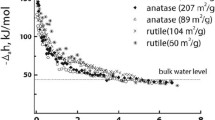Abstract
The water-surface interaction is a research target of great importance for a broad spectrum of technological applications and fundamental scientific disciplines. In the present study, a comparative analysis is performed to clarify the structural and diffusion properties of water on a number of oxide surfaces. Based on the molecular dynamics (MD) simulation method, the water-surface interaction mechanism was investigated for the oxide materials TiO2 (anatase), Al2O3 (corundum), and Fe2O3 (hematite). A comparison of the water-TiO2 interaction with the water-Al2O3 and water-Fe2O3 systems demonstrates the specificity of the adsorption and layer formation on the atomic/molecular level scale. The obtained MD analysis data point to a considerable enhancement of water-TiO2 surface adsorption and a relatively high density distribution profile near the surface. The novel data on water structure and diffusion on oxide surfaces are discussed from the point of view of possible material innovation and design.
Similar content being viewed by others
References
V. E. Hennch, Rep. Prog. Phys. 48, 1481 (1985); V. E. Hennch, Prog. Surface Sci. 9, 143 (1979).
U. Diebold, Surface Sci. Rep. 48, 53 (2003).
A. Fujishima and K. Honda, Nature 238(5358), 37 (1972).
P. A. Thiel and T. E. Madey, “The Interaction of Water with Solid Surfaces: Fundamental Aspects,” Surface Sci. Rep. 7, 211–385 (1987).
H. Knounger, “Hydrogen Bonds in Systems of Adsorbed Molecules,” in The Hydrogen Bond, Ed. by P. Schuster, G. Zundel, and C. Sandorfy (North-Holland, Amsterdam, 1976), Vol. 3, chap. 27, pp. 1263–1364.
K. Barton, Protection against Atmospheric Corrosion Theories and Methods (Wiley, London, 1976).
G. Butler and H. C. K. Ison, Corrosion and Its Prevention in Waters (Reinhold, New York, 1966).
S. Sato and J. M. White, Chem. Phys. Lett. 72, 83 (1980).
C. Leygraf, M. Hendewerk, and G. A. Somorjai, J. Catal. 78, 341 (1982).
J. E. Turner, M. Hendewerk, and G. A. Somorjai, Chem. Phys. Lett. 105, 581 (1984).
C. Leygraf, M. Hendewerk, and G. A. Somorjai, J. Solid State Chem. 48, 35 (1982).
R. L. Kurtz and V. E. Hennch, Phys. Rev. B: Condens. Matter Mater. Phys. 36, 3414 (1987).
W. Smith, T. R. Forester, and I. T. Todorov, The DL-POLY User Manual v. 2.20 (2009).
R. S. Kavathekar, P. Dev, N. J. English, and J. M. D. MacElroy, “Molecular Dynamics Study of Water in Contact with the TiO2 Rutile-110, 100, 101, 001 and Anatase-101, 001 Surface,” Mol. Phys. 109, 1649–1656 (2011).
B. Guillot and N. Sator, “A Computer Simulation Study of Natural Silicate Melts. Part I: Low Pressure Properties,” Geochim. Cosmochim. Acta 71, 1249–1265 (2007).
M. Matsui and M. Akaogi, Mol. Simul. 6, 239 (1991).
M. C. Mitchell, M. Gallo, and T. M. Nenoff, “Computer Simulations of Adsorption and Diffusion for Binary Mixtures of Methane and Hydrogen in Titanosilicates,” J. Chem. Phys. 121, 1910 (2004).
V. V. Hoang, “Molecular Dynamics Study on Structure and Properties of Liquid and Amorphous Al2O3,” Phys. Rev. B: Condens. Matter Mater. Phys. 70, 134204 (2004).
B. T. H. L. Khanh, V. V. Hoang, and H. Zung, “Structural Properties of Amorphous Fe2O3 Nanoparticles,” Eur. Phys. J. D 49, 325–332 (2008).
C. Xiaobo and S. S. Mao, “Titanium Dioxide Nanomaterials: Synthesis, Properties, Modifications, and Applications,” Chem. Rev. 107, 2891–2959 (2007).
D. K. Belashchenko, “Computer Simulation of Structure and Properties of Non-Crystallic Oxides,” Adv. Chem. 66, 9 (1997).
G. S. Herman, Z. Dohnalek, N. Ruzycki, and U. Diebold “Experimental Investigation of the Interaction of Water and Methanol with Anatase-TiO2 (101),” J. Phys. Chem. B 107, 2788–2795 (2003).
S. Yamamoto, T. Kendelewicz, J. T. Newberg, G. Ketteler, D. E. Starr, E. R. Mysak, K. J. Andersson, Hirohito Ogasawara, Hendrik Bluhm, Miquel Salmeron, Gordon E. Brown, Jr., and Anders Nilsson, “Water Adsorption on α-Fe2O3 (0001) at Near Ambient Conditions,” J. Phys. Chem. C 114, 2256–2266 (2010).
Author information
Authors and Affiliations
Additional information
The article is published in the original.
Rights and permissions
About this article
Cite this article
Dushanov, E., Kholmurodov, K. & Yasuoka, K. Molecular dynamics studies of the interaction between water and oxide surfaces. Phys. Part. Nuclei Lett. 9, 541–551 (2012). https://doi.org/10.1134/S1547477112060064
Published:
Issue Date:
DOI: https://doi.org/10.1134/S1547477112060064




